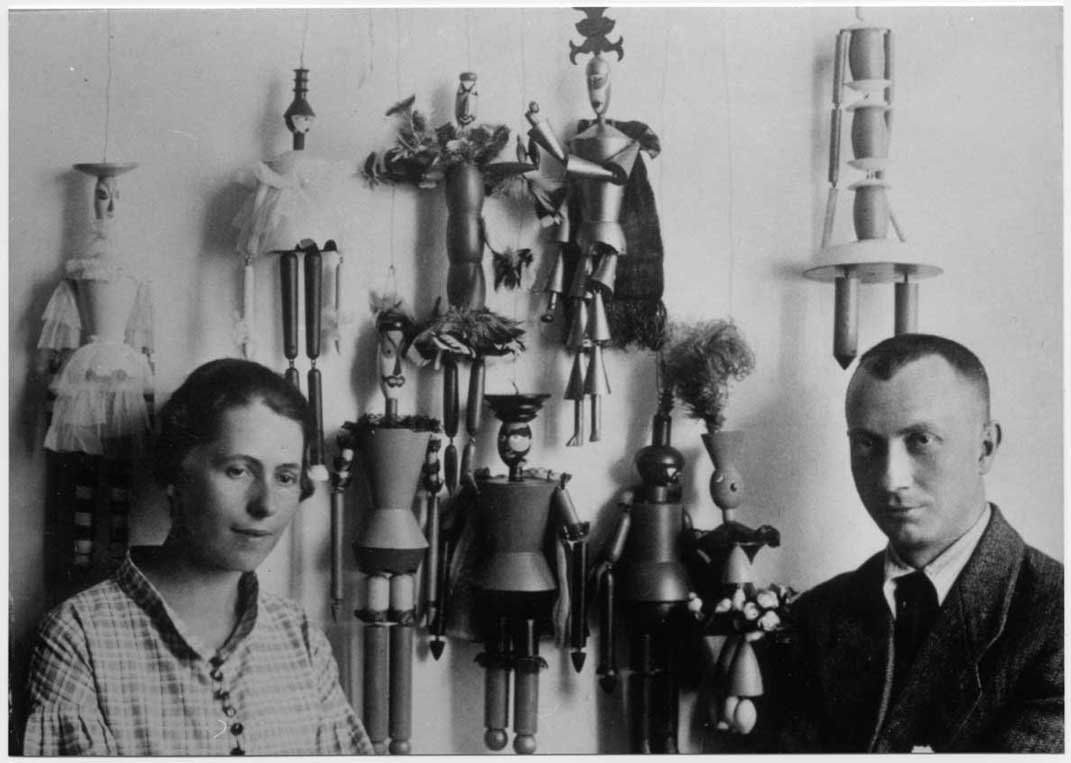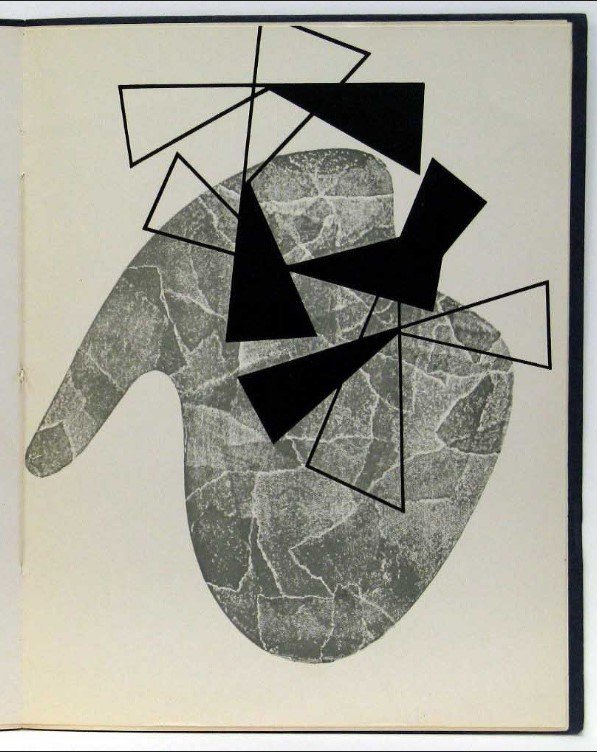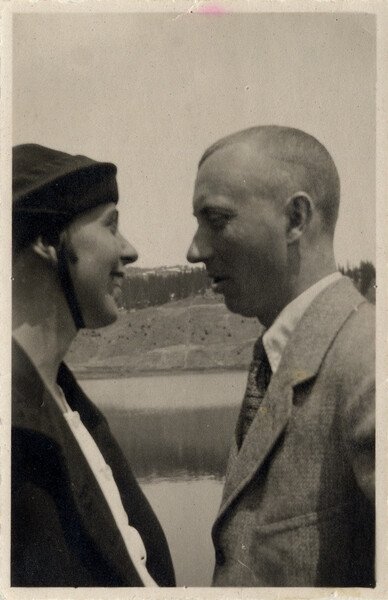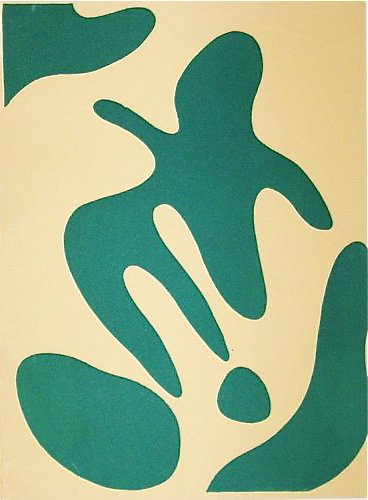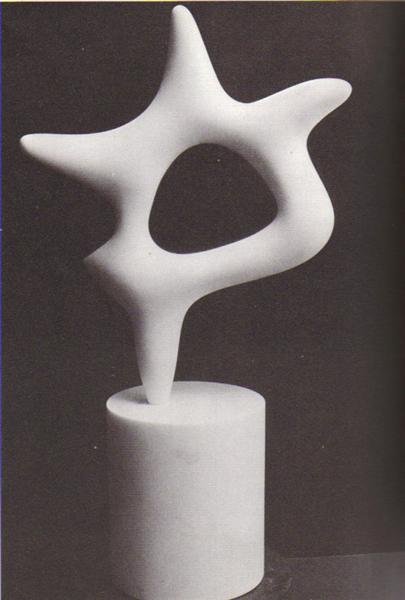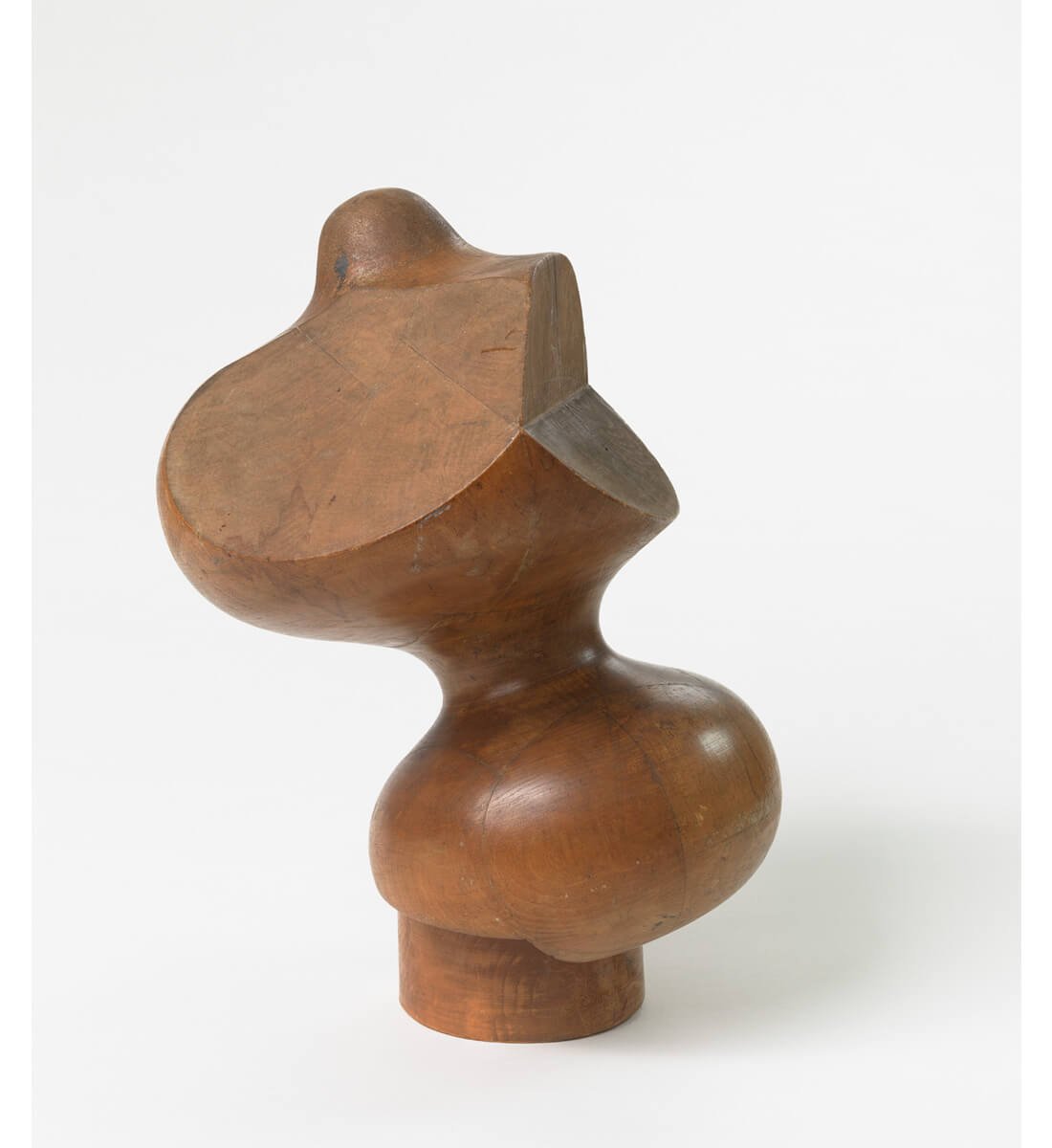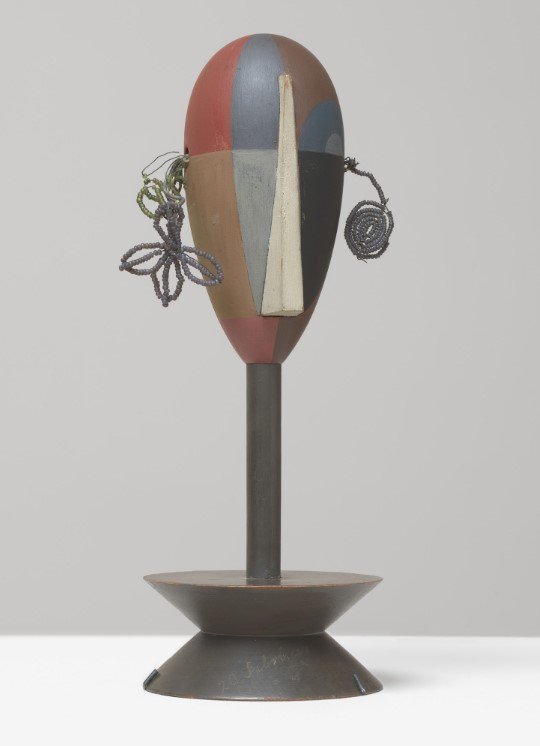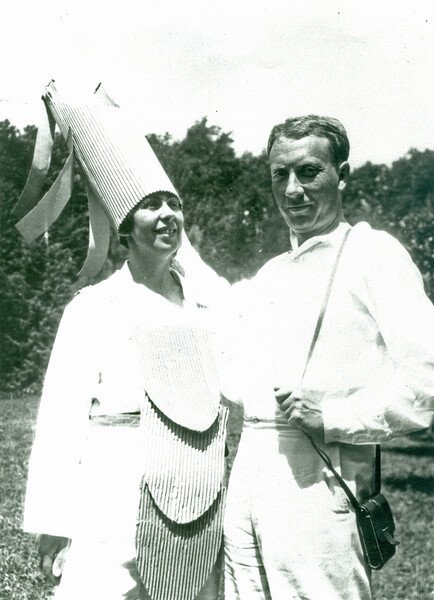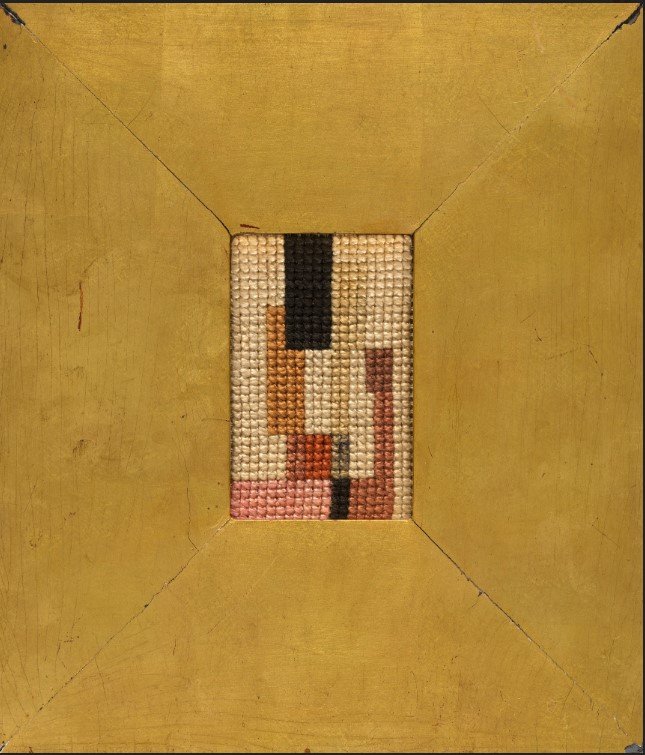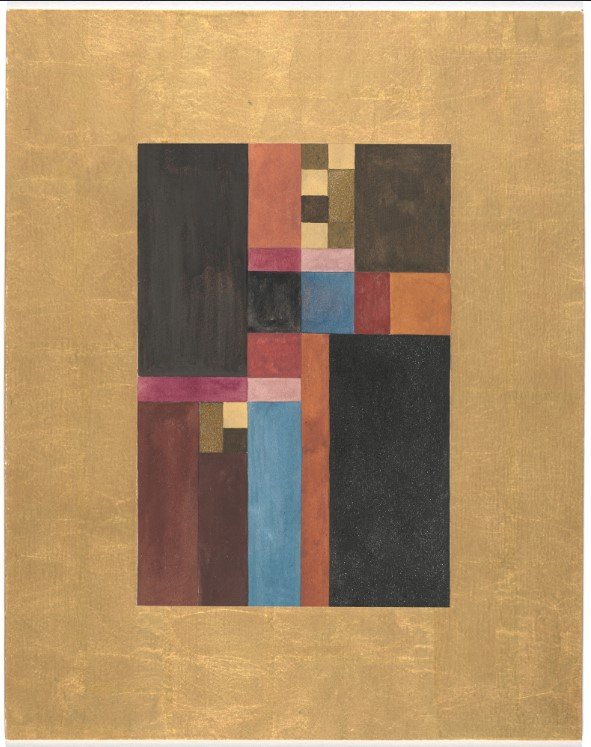Episode #115: Modern Love: Hans (Jean) Arp and Sophie Taeuber-Arp
Listeners, I heard you—a bunch of self-admitting hopeless romantics who wanted to hear more about people bound by attraction, fascination. By love. Though there are examples of romantic and sexual relationships between creators that are sprinkled throughout art history as we know it, it’s true that we have the most information about relationships from folks who lived in the last century—because we have greater access to documentation recording the lives of these people, and because, as the 20th century progressed, people—artists, perhaps especially—became more vocal about their relationships, less inhibited. Modern artists, artists especially from the first half of the 20th century, lived their art, and their relationships, out loud-- writing about them, talking about them, and sometimes even creating works of art about them.
This season, I’m rounding up stories about modern artists in love, in lust, in relationships— digging into these individuals, see how their liaisons, marriages, affairs, and connections played in or on their respective works of art, and how, if anything, they affected art history as we know it. I, for one, believe that it’s time for Modern Love.
Today: it’s one of the most collaborative, creative couples of the century— meet Hans (Jean) Arp and Sophie Taeuber-Arp.
Please SUBSCRIBE and REVIEW our show on Apple Podcasts and FOLLOW on Spotify
SPONSORS:
Lume Deodorant: Control Body Odor ANYWHERE with @lumedeodorant and get over 40% off your starter pack with promo code ARTCURIOUS at lumedeodorant.com/ARTCURIOUS! #lumepod
Shopify: Sign up for a one-dollar-per-month trial period at shopify.com/artcurious
To advertise on our podcast, please reach out to sales@advertisecast.com or visit https://www.advertisecast.com/ArtCuriousPodcast
Episode Credits:
Research by Kristen Hansen. Production and Editing by Kaboonki. Theme music by Alex Davis. Additional music by Storyblocks. Logo by Vaulted.co.
ArtCurious is sponsored by Anchorlight, an interdisciplinary creative space, founded with the intent of fostering artists, designers, and craftspeople at varying stages of their development. Home to artist studios, residency opportunities, and exhibition space Anchorlight encourages mentorship and the cross-pollination of skills among creatives in the Triangle.
Recommended Reading
Please note that ArtCurious is a participant in the Bookshop.org Affiliate Program, an affiliate advertising program designed to provide a means for sites to earn advertising fees by advertising and linking to bookshop.org. This is all done at no cost to you, and serves as a means to help our show and independent bookstores. Click on the list below and thank you for your purchases!
Episode Transcript
If you love ArtCurious, help us keep it going! Become a supporter at patreon.com/artcurious for as little as $4 a month.
Throughout art history, there have been many memorable romantic collaborators. Modern Art is no exception. We’ve discussed quite a few already, from Lee Miller and Man Ray, to Max Ernst and Dorothea Tanning. There are many partnerships we’re not going to cover this time around, though we’ve discussed them a bit in the past: Gustav Klimt and Emilie Floge, a relationship immortalized in Klimt’s 1908 masterwork, ‘The Kiss’; the marriage of Georgia O’Keeffe and Alfred Stieglitz. Today, we’re looking at the creative collaborations between a couple sometimes known as the “Quintessential Dada Pairing,” a couple so playful, so full of team spirit, that they continue to inspire generations of artists even today.
Some people think that visual art is dry, boring, lifeless. But the stories behind those paintings, sculptures, drawings, and photographs are weirder, more outrageous, or more fun than you can imagine. ArtCurious Season 13 is all about Modern Love, and today we’re homing in on Hans, known as Jean Arp, and Sophie Taeuber-Arp. This is the ArtCurious Podcast, exploring the unexpected, the slightly odd, and the strangely wonderful in Art History. I'm Jennifer Dasal.
As the so-called Quintessential Dada couple, Jean Arp and Sophie Taeuber-Arp were immersed in a creative environment that prized a rejection of the traditional—and by traditional, that even included the traditional manner of making art, which often involved the meticulous planning and creation of each work. For Jean Arp, chance—mistakes—a lack of planning—was exciting, as if chaos and randomness were worthy collaborators all on their own.
Jean Arp wasn’t born Jean—at his birth on September 16, 1886, he was bestowed with the name Hans Peter Wilhelm Arp, a name that speaks of the circumstances of history and geography. Hans Arp, you see, was from France. Yep, I said France, but he was born in Strasbourg, in the Alsace-Lorrain region, and in the aftermath of the Franco-Prussian war in 1870 through 1871, this region of France was actually under German rule—it would remain so until after the armistice of World War I. Hans Arp felt this push-and-pull within his own family, too, as his mother was a French-speaking Alsatian, but his father was German. The difference in his parents’ heritage allowed him to not bind to a singular nationality or language-- he was able to establish his own unique cultural identity that would later be reflected in his art via these fluid movements between art forms, materials, and styles. In a way, then, his background gave him a special kind of freedom, a freedom to set aside strict categories and demarcations, and to figure things out on his own. With such outside-of-the-box thinking, it is no surprise that he would become one of the leaders of the European avant-garde during the first half of the 20th century.
Hans Arp began his artistic training in his native Strasbourg until 1904 when, as a teenager, he began traveling in search of better educational opportunities, moving first to Paris before trekking over to Weimar, Germany, to study at the Kunst Schule, the art school, there, and then moving on to the world-famous Académie Julian, back in Paris in 1908. Arp was excited to meet fellow students and learn about the latest possibilities and techniques to produce the latest and most cutting-edge modern art. But sadly, his reality did not match up with his expectations. It seems that his experience was similar in this way to that of Anni Albers, whose life we discussed at the beginning of this season. In both Weimar and in Paris, Hans Arp was met with time-honored educational techniques based on the study of nature and its close reproduction via calculated techniques and purposeful execution. Now, let me be clear that there’s absolutely nothing wrong with learning the process of artmaking in these ways. But it wasn’t what Hans Arp was looking for. In fact, it was the opposite of those ideas of chance and the bucking of tradition that meant so much to him.
Disillusioned, he thus abandoned his studies, and abandoned city life altogether. He needed to get away, spend some time in solitude in a peaceful spot, surrounded by nature. Switzerland, he decided, was where it was at, and it proved to be an incredible time to think and experiment, with the hope of discovering new artistic expression through practice rather than instruction. In regard to his time of solitude and practice, Arp stated, quote, “I undertook the first attempts to overcome the preconceived mold of conventional art. It was an agonizing time[...]. I read, wrote poetry, sketched, painted and made tiny sculptures. I destroyed all my works from that time. Those huge pictures painted in black, gray and white were no true abstractions of landscape, people, objects as one finds in the works of cubists. My canvases, the result of months of tormented work, were covered in black mesh, a network of strange scripts, runes, lines, blots. My colleagues shook their heads over them and thought they were just sketches that failed to come off.” Unquote.
From Arp’s quote here, you’ll note that he mentions his colleagues. Because he wasn’t a total hermit in Switzerland. In fact, he was the opposite. He spent a bunch of quality time on his own, but he also brought a community of artists together to begin the first important modern art alliance in Switzerland, Der Moderne Bund (which translates to Modern Bund, or the Modern League). And via Der Moderne Bund, Hans would meet other notable artists of the time, like Wassily Kandinsky, with whom he would exhibit with in Munich at the inaugural exhibition of Der Blaue Reiter (or The Blue Rider) in 1912. With every alliance he made, he hoped to achieve a singular goal: to make fascinating, accessible, and avant-garde works of art.
Hans Arp had a little bit of a nomadic streak, at least in this earlier period of his life, so after his Switzerland stint, he returned to Paris for a short while, where he mingled with yet more with like-minded artists and writers, such as Pablo Picasso, Sonia and Robert Delaunay, Amedeo Modigliani, and Guillaume Apollinaire. Unfortunately, though, he wasn’t able to remain there for long. When World War I broke out in 1914, Hans was called to the German consulate for conscription into the German army. But just as he was opposed to traditional methods of artmaking, he was also firmly opposed to war, and so he did the only thing he could think to do in order to escape his military fate: he feigned insanity and fled Paris, escaping back to neutral Switzerland, settling this time in Zurich. It was a life-changing move in several ways: it allowed him to avoid battle; it provided him with the opportunity to become a founding member of the Dada movement in that city, and, most importantly, it led him to meet the love of his life: Sophie Taeuber.
Sophie Henriette Gertrude Taeuber was born in Davos, Switzerland, on January 19, 1889, as the fifth child born to a middle-class Prussian family. But her somewhat comfortable upbringing didn’t mean that her life was not without its own hardships. Sophie’s father, Emil, succumbed to tuberculosis when she was only two years old, and consequently, her mother, also named Sophie, toiled to support her family, moving them to the town of Trogen to open a bed-and-breakfast. But her mother encouraged Sophie as a creator, teaching her first to sew, which led to an interest in working with textiles. Eventually she enrolled at the School of Applied Arts in Saint Gallen, Switzerland, for two years, where—though a multi-disciplined artist who was curious about everything and anything—she focused primarily on drawing and textiles. And that was nice for a time, but she—like her future husband—felt constrained by her instructors, so she jumped around, experimenting with different academies and programs, moving this time to Germany—it’s almost like she and Hans Arp were acting in reverse of one another, geographically-speaking. Between 1911 and 1913, her varied interests led her to split her time between the Teaching and Experimental Studio for Applied and Liberal Arts in Munich and the School of Applied Arts in Hamburg. She took classes in textile art, dance, weaving and beadwork. She created whatever she wanted, whenever she wanted—it didn’t matter, as long as it was imbued with something simple: beauty. For Taeuber, it was something she often saw others push aside in favor of creating art that MEANT SOMETHING—imagine those two words in huge capital letters—but she resisted that concept, later noting, quote, “The intrinsic decorative urge should not be eradicated. It is one of humankind’s deep-rooted, primordial urges.”
After her studies in Germany, Sophie returned to Zurich to be closer to family. During this time, influenced by her studies in textile design and cubism, she began creating abstract paintings and sculptures, inspired by the non-representational pieces she’d witnessed in Germany. Sophie also spent this time exploring two of her other passions: applied art, and modern dance. Quickly, to define applied art—it’s adding design and decoration to everyday, practical objects to make them more beautiful, more pleasing, so think lamps, furniture, dishes, and so forth. With her adoration of beauty, it makes sense that Taeuber would gravitate to this. But modern dance changed her, too—she learned to understand the narrative and expressionistic aspects of dance and to see how they could be intuitively applied in any work of art, not just dance. For her, art was art—not just fine arts, meaning painting or sculpture, but also wall hangings, jewelry, dance, rugs, embroidery, drama. It was all connected, all fascinating to her. Everything was worth questioning, beautifying, changing, experimenting with, and attempting something new. And perhaps attempting something new with someone new. That is coming up next--right after this quick ad break—remember that you can join us over on Patreon for a few bucks a month and get this show ad-free: patreon.com/artcurious.
Welcome back to ArtCurious.
In 1915, after the beginning of the First World War, Sophie Taeuber and Hans Arp both found themselves in Zurich, living in the same city for the first time—and it was there, at an art exhibition at the Galerie Tanner celebrating Hans’s works, that they first met. (Some accounts declare that the artists met while at one of the Dada cabarets in Zurich, but this doesn’t track with Hans’s own account of the events). For his part, it appears that Hans was already infatuated with Sophie—or at least with her art. He seems to have been familiar with her work even before meeting the artist herself, later noting that he was enthralled by her extraordinary craftsmanship as well as the geometric constructions in her paintings and in textile works. Hans was besotted with her creativity, and soon enough, with her. Ever the romantic, he’d later say, quote, “The exhibition that was held at the Galerie Tanner in Zurich, in November 1915, was to be the greatest event of my life. It was where I met Sophie Taeuber for the first time.”
It makes sense that Hans Arp and Sophie Taeuber would find themselves in a relationship, as they had such similar goals: to move away from artistic conventions and to experiment, experiment, experiment. This led to a partnership that was absolutely essential to them as creators. Both before their marriage in 1922 and throughout their lives after, they blended their works together, collaborating on tapestries, drawings, collages, and sculptures. Their first collaborations were in the fields of dance and performance, where they experimented with a range of styles and techniques. In 1916, they began working together on the creation of masks and puppets, which they used in their performances.
Hans published books of poetry for which Sophie made illustrations, she created tapestries reflecting their dual designs. Though they were amazing creators individually, their works reached an altogether different height when they began their collaboration. One work, titled Eheplastik (Marital Sculpture), a small, curvy wood sculpture from 1937 that at once feels like a geometric abstraction and reads figural at the same time, is often described as one of the significant single pieces created by the couple. In a 1993 article, writer Renee Riese Hubert describes the piece as a perfect metaphor for the couple. She writes, quote: “The playful title is significant in itself, for it designates art and marriage in such a way as to make them inseparable…Not only does the title designate the work of art produced by a couple, it also suggests that the marriage of true minds or skilled fingers had sufficed all by itself to give birth to the work of art. And as this artifact represents marital union, it functions simultaneously as object and subject.”
Throughout the 1920s and 1930s, Hans and Sophie continued to explore, create, and exhibit their art. Individually, Sophie concentrated on textiles, applied arts, and even interior design, a passion she would explore even more fully as the 30s progressed. For his part, Hans—who had gained recognition for his collages and other chance-inspired pieces during his Dada years, found himself at the forefront of another burgeoning art movement, Surrealism. The first Surrealist exhibition, held at the Galerie Pierre in Paris, included Arp alongside other folks like Giorgio de Chirico, Max Ernst, Paul Klee, Man Ray, Andre Masson, and Joan Miro. Part of Arp’s inclusion here was not only because of his excellent work, but also one of geographic proximity to the core of Surrealism, Paris. In 1929, after living in Zurich for nearly two decades and after being married for seven years, the couple sought a change of location, and after being granted citizenship, the Arps moved to France. Hans—now going by the more French version of his name, Jean—was thus in the right place at the right time to be submerged into the Surrealist lifestyle, even enjoying his own solo exhibitions in Surrealist-specific galleries, as well as two hugely important exhibitions that showcased his work in the U.S. for the first time, both at the Museum of Modern Art in New York: First, “Cubism and Abstract Art” in 1936, and later as part of the landmark show we’ve mentioned previously on ArtCurious: “Fantastic Art, Dada, Surrealism” from later that same year. But their individual projects were, naturally, complemented by their co-productions. In France, Sophie was sought after for her design skills, most notably for the Strasbourg entertainment complex known as the Aubette, which she completed with her husband and fellow artist Theo van Doesberg. Sophie was commissioned to redesign the bar and tearoom of the Aubette. She had her hands full at home, too, redesigning the couple’s stylish live-in studio on the outskirts of Paris.
Sophie and Jean lived together in Paris for just over a decade, until 1940, when the Nazis occupied France. Fleeing the capital, the Arps, like many others, moved down south, to the beautiful town of Grasse, where the couple lived their best artsy life as part of an artist colony that they spearheaded alongside the Italian artist Alberto Magnelli, his wife Susi Gerson, and Sonia Delauney, who joined in after the 1941 death of her husband, fellow artist Robert Delauney—talk about yet another awesome artist couple. For a couple of years, the colony members produced drawings and lithographs in a true collaboration, with each artist credited equally for the works’ creations. Their items were eventually published in Paris in 1950 under the title The Grasse Album, and is yet another example of the warm atmosphere that the Arps fostered creativity and cooperation in every environment they visited.
As you might remember from our first episode this season when we discussed the wartime problems faced by Max Ernst, you’ll know that the South of France didn’t remain a refuge for long. As Axis troops moved into the previously unoccupied region, the Arps fled, returning home to Zurich with hopes of securing passage to emigrate to the United States. But alas, it wasn’t to be. On January 13, 1943, Sophie Taeuber-Arp missed a late-night tram home, and she sought refuge from the cold by sleeping in a nearby home. It was later discovered that the home had a faulty gas stove, and Sophie died in her sleep from accidental carbon monoxide poisoning. She was 54 years old.
Jean Arp was naturally devastated by his wife’s death. He fell into a deep depression and disappeared from the public eye for nearly a decade, spending time in seclusion to grieve the love of his life the only way that he knew how, by creating art. Arts journalist Tessa Solomon writes that after Sophie’s death, Jean, quote, “...ripped up some of her works to form new collages from the fragments, desperately extending her spirit through the act of revision.” He wrote lovesick poetry and worked to catalogue Sophie’s works. But eventually, especially after the end of World War II, Jean Arp returned to his own projects. He began sculpting again, and after moving back to France in 1946, he devoted himself to his work more fully, and ultimately it paid off, as he reached a new level of international acclaim. In the 1950s and into the 1960s, he enjoyed solo exhibitions around the world, with major retrospectives in both Paris and New York, as well as completing commissions for murals and sculptural reliefs in Europe and the U.S. He found an emotional centerpoint, too, in the late 1940s, in the friend and art collector Marguerite Hagenbach, whom he would eventually marry in 1959. She brought great solace to Arp in the final years of his life before his death in June 1966 at the age of 79.
As is a typical story for many women artists from the 20th century and long before, Sophie Taeuber’s works received a lot less attention than her husband’s did in the decades after her death. Jean of course fought against this, opting to memorialize his wife in small exhibitions that he showcased in their former Parisian suburb studio, the one that Sophie lovingly designed before World War II. And no less than three foundations currently exist in Europe to preserve the works and memory of both Jean and Sophie. Finally, after far too long, both artists are being recognized as playful, exciting creators who were at the forefront of European art in the first half of the century, with Sophie in particular receiving overdue attention as an incredible artist and designer in her own right, someone who doesn’t need to be remembered only as “Jean Arp’s Wife.” In 1995, her home country gave her an even greater amount of attention: from that year until 2016, Taeuber-Arp was featured as part of a redesign of Swiss banknotes. Her face appeared on 50-franc notes, the only woman to ever be featured on Swiss currency.
Thank you for listening to the ArtCurious Podcast. This episode was written, produced, and narrated by me, Jennifer Dasal. HUGE thanks to Kristin Hansen for her great writing and research help for this episode. The ArtCurious theme music is by Alex Davis at alexdavismusic.com, and our brand new, fabulous logo is by the fine folks at Vaulted, check them out at vaulted.co. Our podcast is co-produced by Kaboonki - podcasts, creative video, and more. Subscribe to their show, Subgenre, a podcast about the movies, available on Apple Podcasts, Spotify, and at subgenrepodcast.com. Kaboonki: Leave your mark. The ArtCurious Podcast is sponsored primarily by Anchorlight. Anchorlight is a creative space, founded with the intent of fostering artists, designers, and craftspeople at varying stages of their development. Home to artist studios, residency opportunities, and exhibition space, Anchorlight encourages mentorship and the cross-pollination of skills among creatives in the Triangle. Please visit anchorlightraleigh.com.
The ArtCurious Podcast is also fiscally sponsored by VAE Raleigh, a 501c3 nonprofit creativity incubator, which means you can donate tax-free to ArtCurious to show your support, and you can join us at Patreon for the price of a cup of coffee. Check back with us soon as we explore some of the most unexpected, slightly odd, and strangely wonderful Modern art lovers in art history.


